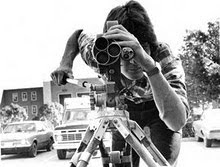Well the truth is it will never be finished. However, the structure of the system can be developed to a point where it is sound enough to work with and that is as close to finished as it will ever be.
There are a couple of terms thrown around in Digital Asset Management: ODBC (Open Database Compliance) and Extensibility. These both are important to any sound DAM system and are both good reasons a DAM system is never finished. One always needs to be planning for obselesence and growth in scope within a project.
I used to have a manager who when talking about the interminable road repairs and renovations in the City of Ottawa would say: "It'll be a nice place, when it's finished". I thought it was hilarious, because it will never happen. The best we can do is enjoy it for what it is while accomodating plans for the future.
The lesson for us in DAM is not to be content with what is satisfying our needs at the moment but to stay in touch with our users and discuss future needs and plan to deal with them.
ODBC and Extensibility will be addressed more directly later, but for now it is sufficient to know the basic definitions.
Open Database Compliance is as the name suggests a state a file system or existing database is in which will permit it to be read, and modified by other databases which share the same ODBC characteristics.
Extensibility is the nature of any structure which permits it to be added to. For example the XMP initiative by Adobe which allows one to attach metadata to files whose formats don't permit the storage of metadata within the file. XMP actually is an acronym for Extensible Metadata Platform. When metadata is embedded in a RAW image file using software capable of doing such a thing, like Adobe Photoshop Lightroom, a sidecar file is created which will reside next to the image file in its directory and contains the metadata as well as links to the original image file.
An excellent real world example of extensibility is a bridge such as the Bloor Viaduct in Toronto, Ontario. Most people will know that the Bloor subway line runs along this bridge, but will not necessarily know that when the bridge was built the subway was a far off project. The engineers built the viaduct with space and support for a rail line to run below the road. By planning to be able to extend the utility of the bridge they were creating an object with extensibility.
Well, this blog entry is about the goal and what the DAM system might look like for you when it's ready to use.
Essentially a DAM system is a database. It need not be an elaborate relational database and it need not even include image storing capability, although that would be a bad idea. What the database must include is fields which correspond to basic components of the files you are managing.
Now a field is a constituent component of a database which stores information about the individual items which the database is concerned with. One or more fields of information about any single item are considered a record.
Some of the fields we are concerned with are:
- filenames
- file formats
- creation dates
- keywords
- categories
- exif metadata
- iptc metadata
- xmp metadata
We will discuss the definitions of all these and the many other data fields available to us later.
Much of this data is provided for us by our capture devices. Whether they be a digital camera or scanner or a pencil & paper or typewriter in the case of analog media.
So, what does a database look like?
This part, like ultimately every part of DAM is up to you.
There are many software programs available expressly for Digital Asset Management. Which one you choose should depend on all the considered factors we will discuss in this blog. Probably the most important of these are; how many assets you will want to control and how many users you want to distribute them to. Also how you intend to distribute the assets and how much access & control you wish to give to others with an interest in the DAM system.
You may build a DAM system for one user or One Client to use the vernacular of the technologically prepossessed, using a single computer and a database. You may also build a DAM system for groups from two users to the whole world, using networks, servers and web access.
We'll discuss them all.

No comments:
Post a Comment